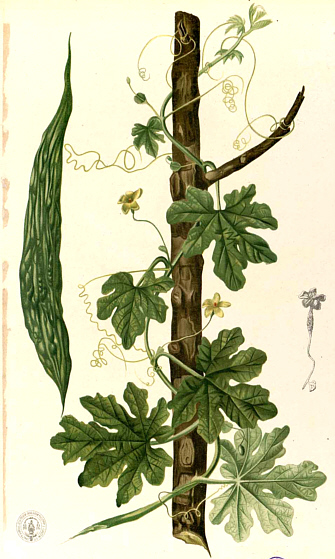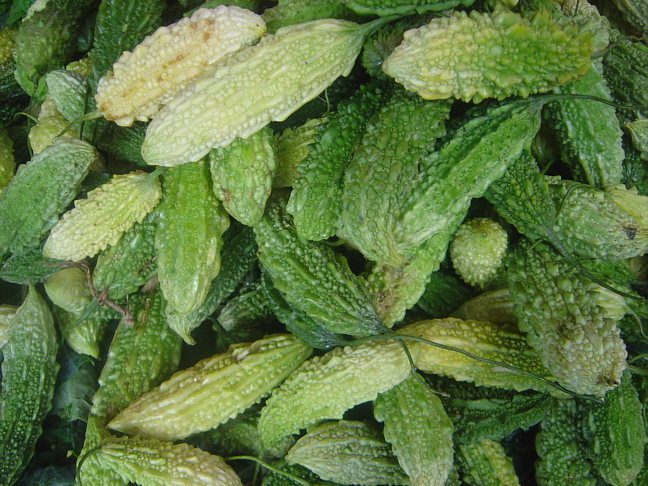

Zitierweise / cite as:
Carakasaṃhitā: Ausgewählte Texte aus der Carakasaṃhitā / übersetzt und erläutert von Alois Payer <1944 - >. -- Anhang A: Pflanzenbeschreibungen. -- Momordica charantia L. -- Fassung vom 2007-07-28. -- URL: http://www.payer.de/ayurveda/pflanzen/momordica_charantia.htm
Erstmals publiziert: 2007-07-28
Überarbeitungen:
Anlass: Lehrveranstaltung SS 2007
©opyright: Dieser Text steht der Allgemeinheit zur Verfügung. Eine Verwertung in Publikationen, die über übliche Zitate hinausgeht, bedarf der ausdrücklichen Genehmigung des Verfassers
Dieser Text ist Teil der Abteilung Sanskrit von Tüpfli's Global Village Library
WARNUNG: dies ist der Versuch einer
Übersetzung und Interpretation eines altindischen Textes. Es ist keine
medizinische Anleitung. Vor dem Gebrauch aller hier genannten Heilmittel wird
darum ausdrücklich gewarnt. Nur ein erfahrener, gut ausgebildeter ayurvedischer
Arzt kann Verschreibungen und Behandlungen machen!
Falls Sie die diakritischen Zeichen nicht dargestellt bekommen, installieren Sie eine Schrift mit Diakritika wie z.B. Tahoma.
Verwendete und zitierte Werke siehe: http://www.payer.de/ayurveda/caraka0001.htm

Abb.: Momordica charantia L. - Balsambirne
[Bildquelle. Wikipedia]

Abb.: Momordica charantia L. - Balsambirne
[Bildquelle. Wikipedia]
Drury:
"Momordica Charantia (Linn.) N. O. Cucurbitaceae. Kurula, Beng. Pandipasel, Mal. Pava-kai, Tam.
Description.—Climbing; stems more or less hairy; leaves palmately 5-lobed, sinuate, toothed, when young more or less villous on the under side, particularly on the nerves ; peduncles slender, with a reniform bracteole, male ones with the bracteole about the middle, female with it near the base ; fruit oblong or ovate, more or less tubercled or muricated; seeds with a thick notched margin and red aril; flowers middle-sized, pale yellow. Fl. Aug.—Oct.— W. & A. Prod. i. 348.—Roxb. Fl. Ind. iii. 707.—Wight Icon. ii. t. 504.—M. muricata, Willd.—Rheede Mal. viii. t. 9, 10.-------Cultivated everywhere in the Peninsula.
Medical Uses.—There are two chief varieties differing in the forms of the fruit, the one having the fruit longer and more oblong, the other with the fruit smaller, more ovate, muricated, and tubercled. There are besides these many intermediate gradations. The fruit is bitter but wholesome, and is eaten in curries by the natives. It requires, however, to be steeped in salt water before being cooked. That of the smaller variety is most esteemed. The whole plant mixed with cinnamon, long-pepper, rice, and marothy oil (Hydnocarpus inebrians), is administered in the form of an ointment in psora, scabies and other cutaneous diseases. The juice of the leaves mixed with warm water is reckoned anthelmintic. The whole plant pulverised is a good specific externally applied in leprosy and malignant ulcers.—Rheede. Dr Gibson. Wight.
[Quelle: Drury, Heber <1819 - 1872>: The useful plants of India : with notices of their chief value in commerce, medicine, and the arts. -- 2d ed. with additions and corrections. London : Allen, 1873. -- xvi, 512 p. ; 22 cm. -- s.v.]